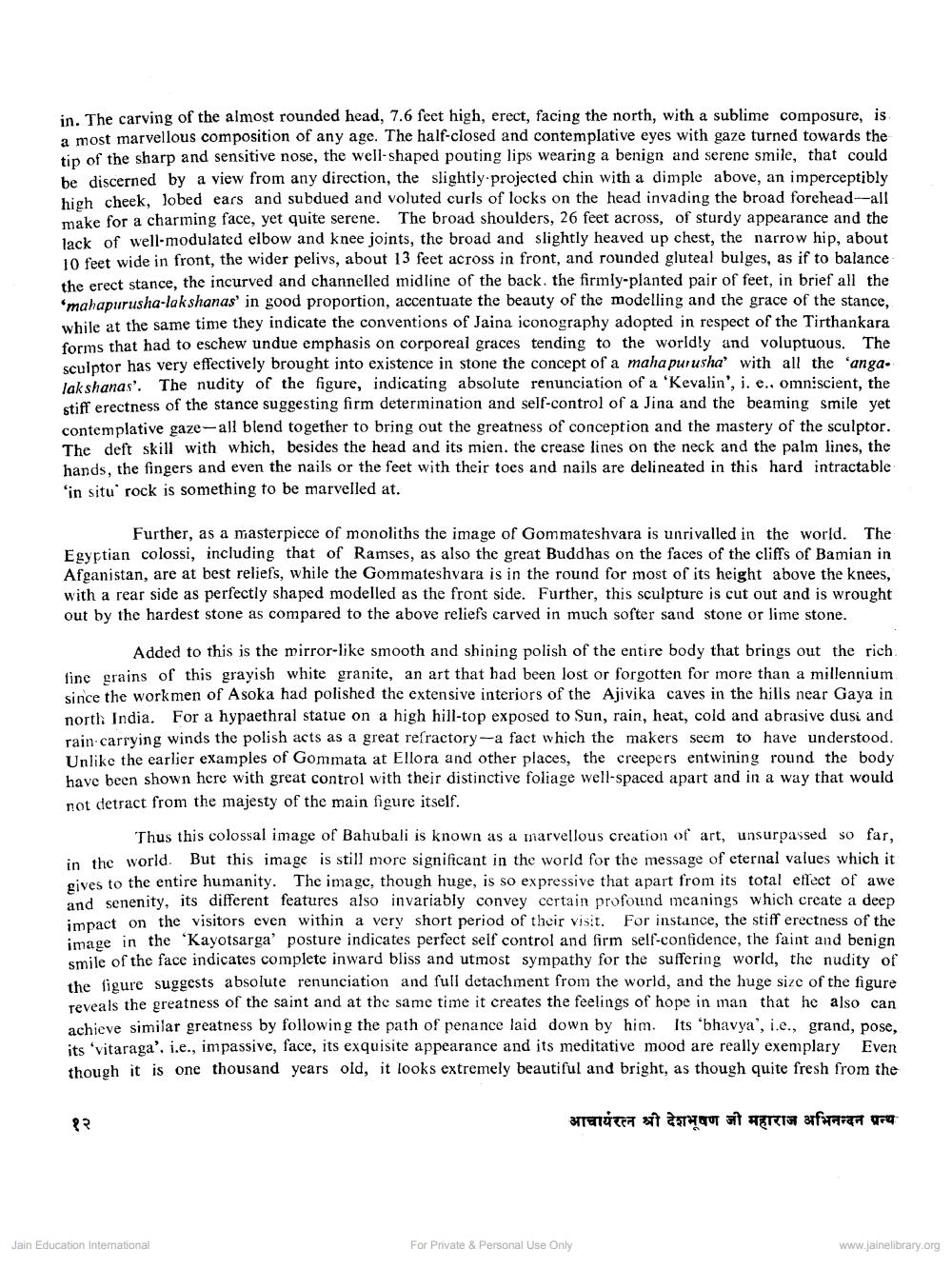________________
in. The carving of the almost rounded head, 7.6 feet high, erect, facing the north, with a sublime composure, is a most marvellous composition of any age. The half-closed and contemplative eyes with gaze turned towards the tip of the sharp and sensitive nose, the well-shaped pouting lips wearing a benign and serene smile, that could be discerned by a view from any direction, the slightly projected chin with a dimple above, an imperceptibly high cheek, lobed ears and subdued and voluted curls of locks on the head invading the broad forehead--all make for a charming face, yet quite serene. The broad shoulders, 26 feet across, of sturdy appearance and the lack of well-modulated elbow and knee joints, the broad and slightly heaved up chest, the narrow hip, about 10 feet wide in front, the wider pelivs, about 13 feet across in front, and rounded gluteal bulges, as if to balance the erect stance, the incurved and channelled midline of the back. the firmly-planted pair of feet, in brief all the mahapurusha-lakshanas' in good proportion, accentuate the beauty of the modelling and the grace of the stance, while at the same time they indicate the conventions of Jaina iconography adopted in respect of the Tirthankara forms that had to eschew undue emphasis on corporeal graces tending to the worldly and voluptuous. The sculptor has very effectively brought into existence in stone the concept of a maha purusha' with all the 'anga. lakshanas'. The nudity of the figure, indicating absolute renunciation of a 'Kevalin', i. e.. omniscient, the stiff erectness of the stance suggesting firm determination and self-control of a Jina and the beaming smile yet contemplative gaze-all blend together to bring out the greatness of conception and the mastery of the sculptor. The deft skill with which, besides the head and its mien. the crease lines on the neck and the palm lines, the hands, the fingers and even the nails or the feet with their toes and nails are delineated in this hard intractable 'in situ' rock is something to be marvelled at.
Further, as a masterpiece of monoliths the image of Gommateshvara is unrivalled in the world. The Egyptian colossi, including that of Ramses, as also the great Buddhas on the faces of the cliffs of Bamian in Afganistan, are at best reliefs, while the Gommateshvara is in the round for most of its height above the knees, with a rear side as perfectly shaped modelled as the front side. Further, this sculpture is cut out and is wrought out by the hardest stone as compared to the above reliefs carved in much softer sand stone or lime stone.
Added to this is the mirror-like smooth and shining polish of the entire body that brings out the rich fine grains of this grayish white granite, an art that had been lost or forgotten for more than a millennium since the workmen of Asoka had polished the extensive interiors of the Ajivika caves in the hills near Gaya in north India. For a hypaethral statue on a high hill-top exposed to Sun, rain, heat, cold and abrasive dusi and rain carrying winds the polish acts as a great refractory--a fact which the makers seem to have understood. Unlike the earlier examples of Gommata at Ellora and other places, the creepers entwining round the body have been shown here with great control with their distinctive foliage well-spaced apart and in a way that would not detract from the majesty of the main figure itself.
Thus this colossal image of Bahubali is known as a marvellous creation of art, unsurpassed so far, in the world. But this image is still more significant in the world for the message of eternal values which it gives to the entire humanity. The image, though huge, is so expressive that apart from its total effect of awe and senenity, its different features also invariably convey certain profound meanings which create a deep impact on the visitors even within a very short period of their visit. For instance, the stiff erectness of the image in the 'Kayotsarga' posture indicates perfect self control and firm self-confidence, the faint and benign smile of the face indicates complete inward bliss and utmost sympathy for the suffering world, the nudity of the figure suggests absolute renunciation and full detachment from the world, and the huge size of the figure reveals the greatness of the saint and at the same time it creates the feelings of hope in man that he also can achieve similar greatness by following the path of penance laid down by him. Its 'bhavya', i.e., grand, pose, its vitaraga'. i.e., impassive, face, its exquisite appearance and its meditative mood are really exemplary Even though it is one thousand years old, it looks extremely beautiful and bright, as though quite fresh from the
१२
आचार्यरत्न श्री देशभूषण जी महाराज अभिनन्दन पन्थ
Jain Education International
For Private & Personal Use Only
www.jainelibrary.org




